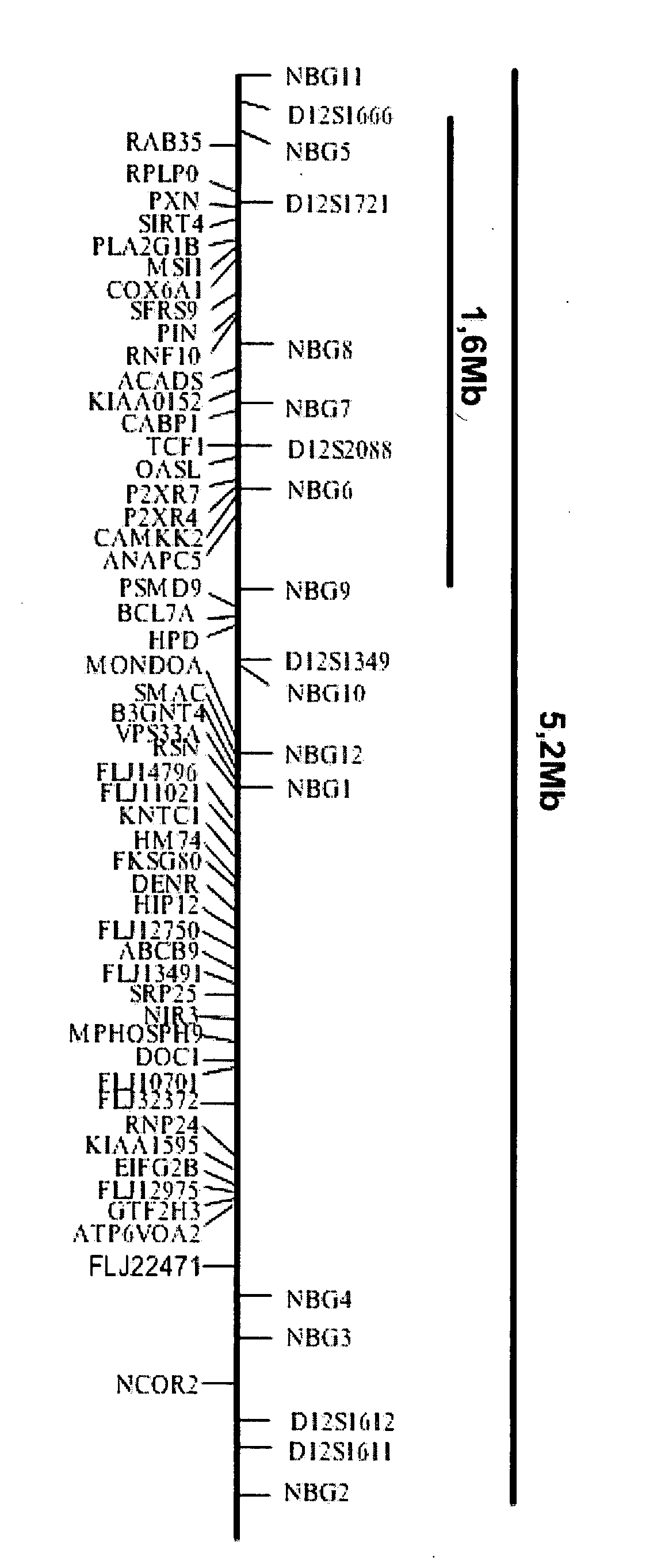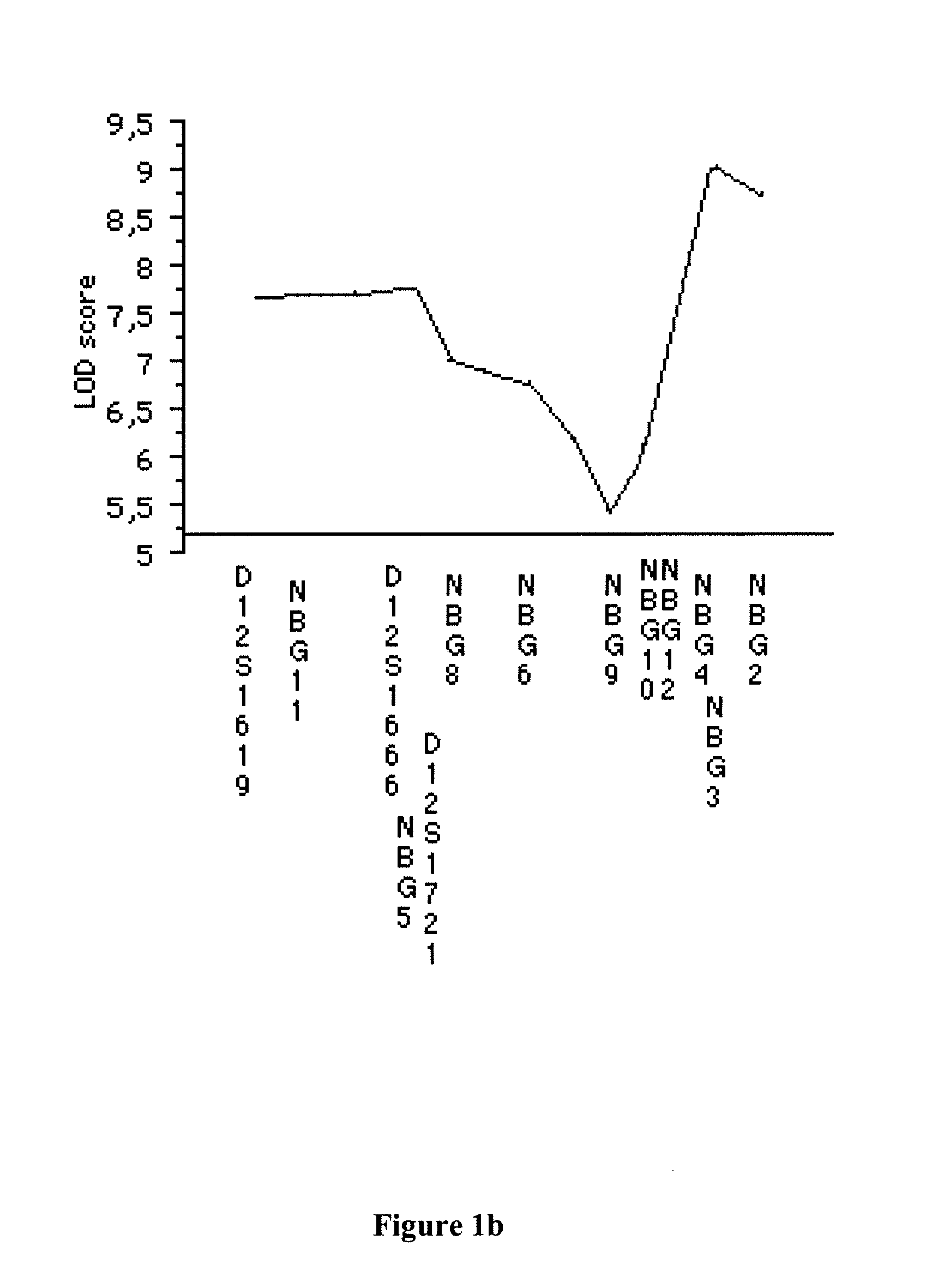Means and methods for diagnosing and treating affective disorders
a technology of affective disorders and methods, applied in the field of nucleic acid molecules, can solve the problems of high blood lithium levels, undiagnosed or inadequate treatment, and inability to respond to high-level lithium, and achieve the effect of shortened polypeptides
- Summary
- Abstract
- Description
- Claims
- Application Information
AI Technical Summary
Benefits of technology
Problems solved by technology
Method used
Image
Examples
example 1
Linkage Analysis of Bipolar Affective Disorder in a Homogeneous Human Population
[0329] 41 families of different sizes containing a total of 485 sampled individuals from the region of Saguenay / Lac St-Jean were used in the linkage analysis. Individuals were distributed according to their diagnoses as follows: 105 individuals afflicted with Bipolar Disorder type I (BPI) or schizoaffective disorder bipolar type; 42 individuals diagnosed with Bipolar Disorder type II (BPII); 54 individuals with recurrent major depression; and 57 individuals with single episode major depression. The remaining 227 individual were unaffected and normal. For the purpose of the calculation, the following classification was used: individuals diagnosed with either BPI, schizoaffective disorder, bipolar type, BPII and recurrent major depression were considered as affected (n=201); individuals with a single major depression episode were scored as unknown phenotype (n=57); and all others diagnoses as unaffected (...
example 2
Physical Mapping and Mutation Analysis of Chromosome 12 Associating the P2X7R to Bipolar Affective Disorders
[0359] The most conservative prediction for the disease-associated region is included between markers NBG11 and NBG2 (see FIG. 1a). This region was delimited according to linkage and association analysis described in Example 1, using genethon markers and NBG markers. The approximate length of this region is 5.2 Mb. Two major gaps (between FLJ10701 and FLJ32372, and between FLJ1466 and MONDOA) were included in this region. At least 73 genes were listed in this area, where 48 are known genes and 25 are unknown but associated to mRNA and / or EST clusters based on the last genome assembly available at UCSC (November 2002). Predicted genes were not listed. However, the estimation of Cl 99% (confidence interval) using GENEFINDER has limited the most interesting region between markers D12S1666 and NBG9. This genomic region covers 1.6 Mb and includes at least 28 genes, and has no majo...
example 3
Polymorphisms Found in the P2X7R in Individuals Suffering from Depression
[0380] Association studies using SNPs in the P2X7R gene was performed in a case / control sample (535 individuals) from a German population. The case group was composed of 36 individuals diagnosed with bipolar type I or type II, and 279 individuals diagnosed with unipolar disorders (i.e. depression) representing 133 affected males and 182 affected females. Among controls, we count The remaining 220 control individuals were normal (i.e. diagnosed as non depressive), and comprising 81 males, 182 females and 14 of unknown gender. The same sexual distribution was noted in both groups.
[0381] SNPs were identified in this sample by using a subgroup of 24 affected individuals. SNPs in the P2X7R gene detected in the German population were similar if not identical to the SNPs seen in the Saguenay / Lac-St-Jean population (see table 12). Other rare missense SNPs were also noted in the German population, such as Arg117Trp (P...
PUM
| Property | Measurement | Unit |
|---|---|---|
| Fraction | aaaaa | aaaaa |
| Fraction | aaaaa | aaaaa |
| Fraction | aaaaa | aaaaa |
Abstract
Description
Claims
Application Information
 Login to View More
Login to View More - R&D
- Intellectual Property
- Life Sciences
- Materials
- Tech Scout
- Unparalleled Data Quality
- Higher Quality Content
- 60% Fewer Hallucinations
Browse by: Latest US Patents, China's latest patents, Technical Efficacy Thesaurus, Application Domain, Technology Topic, Popular Technical Reports.
© 2025 PatSnap. All rights reserved.Legal|Privacy policy|Modern Slavery Act Transparency Statement|Sitemap|About US| Contact US: help@patsnap.com



